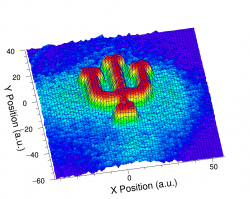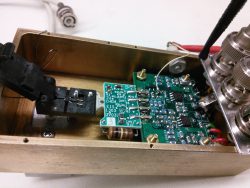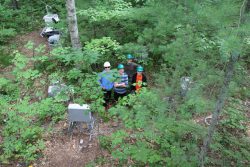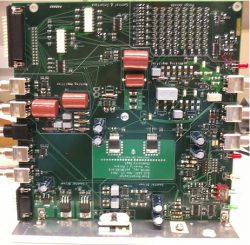See below a sample of projects carried out in EIS

High-Speed Digitizer for Neutron Radiography
The Nuclear Chemistry (deSouza) group developed a novel approach for neutron radiography using Micro Channel Plate detectors (MCP). The electron cloud from the MCP detector passes through a wire plane, inducing a charge on the wires and allowing localization of the cloud. Two planes, one in X and one Y, allow 2D imaging. The key to achieving good spatial resolution is the digitization of the induced signals. Making use of neutron facilities requires high-speed digitizers capable of handling high rates. Two dual-channel PCIe commercial boards from AlazarTech capable of digitizing up to 2GSa/s are used. EIS has designed the wire plane board and delay boards for position determination. EIS has developed the C++ software and Qt user interface to control and handle data acquisition on a Linux based workstation. In addition to the signal digitization, time-of-flight measurement was also required. This is implemented with an independent PCIe FPGA board and custom interface board.
Image from an MCP detector using a low energy neutron beam
EIS contributors: Andy Alexander (custom board), Dave Bancroft (FPGA, software), Rose Burchfield (construction)

Low-Noise Amplifier for Charge Detection Mass Spectrometry
Low-noise amplifier for the M Jarrold group for Charge Detection Mass Spectrometry (CDMS). The combination of front and back end boards, associated with custom power board, allows charge measurment at the single electron level.
EIS contributors: Andy Alexander (design), Rose Burchfield (construction)

Sampling Chambers for Environmental Studies
The Raff group studies thermal and photochemical reactions that occur on environmental surfaces. The group has a strong interest in thermal and photochemical reactions of NOy (NO, NO2, N2O5, HONO, HNO3, etc) and other oxidants with organic compounds on environmental surfaces. A campaign of measurements in Northern Michigan made use of 5 test chambers designed and built at the Department of Chemistry. The whole system was controlled with a computer system designed in EIS. Strong constraints was put on the system as it was operated exposed to the elements. The system has been consequenlty used in mulitple campaigns at the IU research reserve.
EIS contributors: John Poehlman (design, software), Andy Alexander (design), Rose Burchfield (construction)

Potentiostat for Electrochemistry
This general purpose potentiostat was designed and built for the Peters group. The emphasis was on low noise, stability, durability and simplicity rather than high speed and fancy features. To minimize the noise, the digital signals are optically isolated, the analog signals are differential, and the power supply is in a separate box. It is controlled using Labview programs written and maintained by members of the group.
EIS contributors: Andy Alexander (design), Rose Burchfield (construction)
